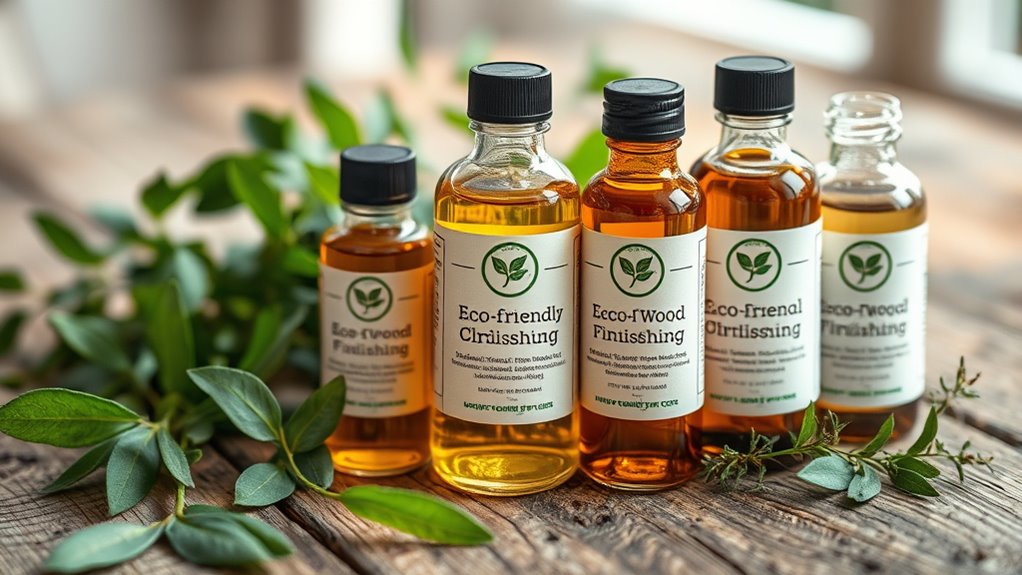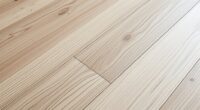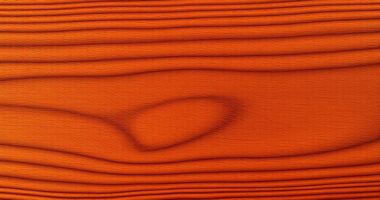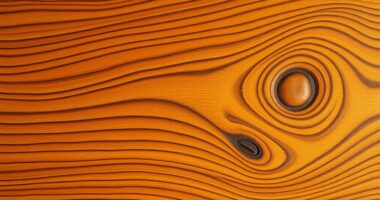Eco-friendly wood finishing products let you protect and enhance your wood surfaces without harmful chemicals. Natural oils like tung or linseed offer waterproof, grain-enhancing finishes, while plant-based waxes create durable, low-VOC seals with beautiful matte or satin finishes. Water-based polyurethanes and bio-coatings provide safe, long-lasting protection. Choosing certified, low-VOC options supports sustainability and healthier indoor environments. Keep exploring to discover how these eco-friendly finishes can transform your projects sustainably and safely.
Key Takeaways
- Natural oils like Tung and boiled Linseed provide eco-friendly, chemical-free wood finishes that enhance grain and durability.
- Plant-based waxes such as carnauba, beeswax, and rice bran create sustainable, low-VOC sealants with matte or satin finishes.
- Water-based and bio-polyurethane coatings reduce VOC emissions, offering safer, eco-conscious protection for indoor wood surfaces.
- Certified products with labels like GreenGuard and LEED ensure low or no VOCs, supporting healthier indoor environments.
- Choosing plant-based, non-toxic formulations minimizes chemical exposure, supports sustainability, and promotes eco-friendly wood finishing.
Natural Oils for Wood Finishing
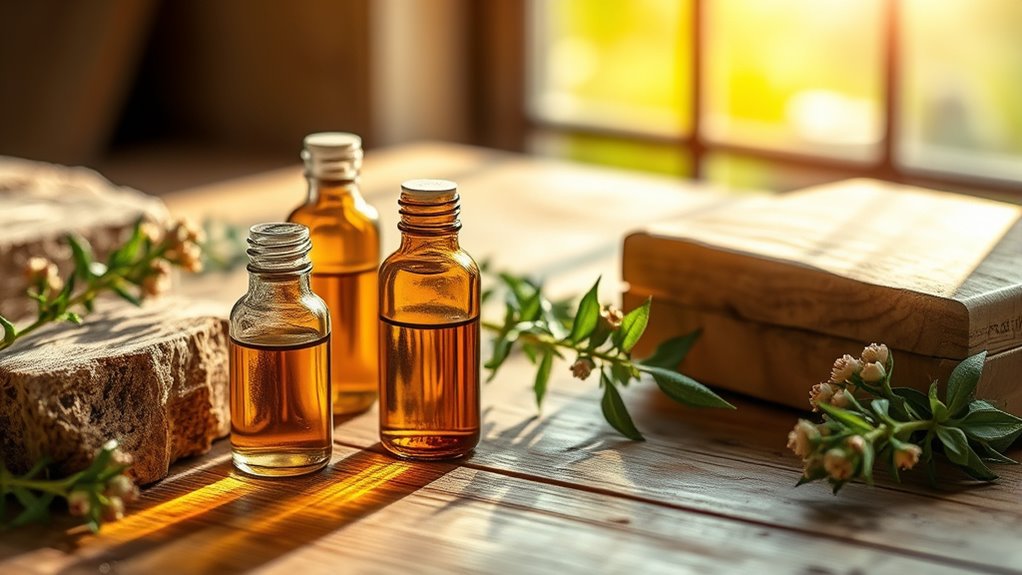
Natural oils are a popular choice for finishing wood because they enhance the wood’s appearance while offering eco-friendly benefits. You can choose from various types like pure Tung oil, which creates a waterproof, durable finish and highlights wood grain, or boiled Linseed oil, known for quick drying and enhancing color. These oils also provide a natural wood protection that reduces the need for chemical treatments. Incorporating sustainable practices such as responsible sourcing can further reduce environmental impact. Danish oil blends oils and solvents for versatile use, while Teak oil is ideal for outdoor furniture, providing a natural matte look and weather protection. Refined hemp oil offers a sustainable option, delivering a durable finish without harmful chemicals. These oils are perfect for flooring, kitchen surfaces, outdoor furniture, and crafts. They darken wood slightly, giving a rich appearance, and protect against moisture, all while being non-toxic and environmentally friendly. Additionally, mindful application techniques can help maximize longevity and ensure an even finish. Incorporating self-care techniques such as mindful application can enhance the natural finish and prolong its lifespan. Dog names can even serve as inspiration for creative naming, reflecting personality or appearance.
Eco-Friendly Wax Finishes and Sealants
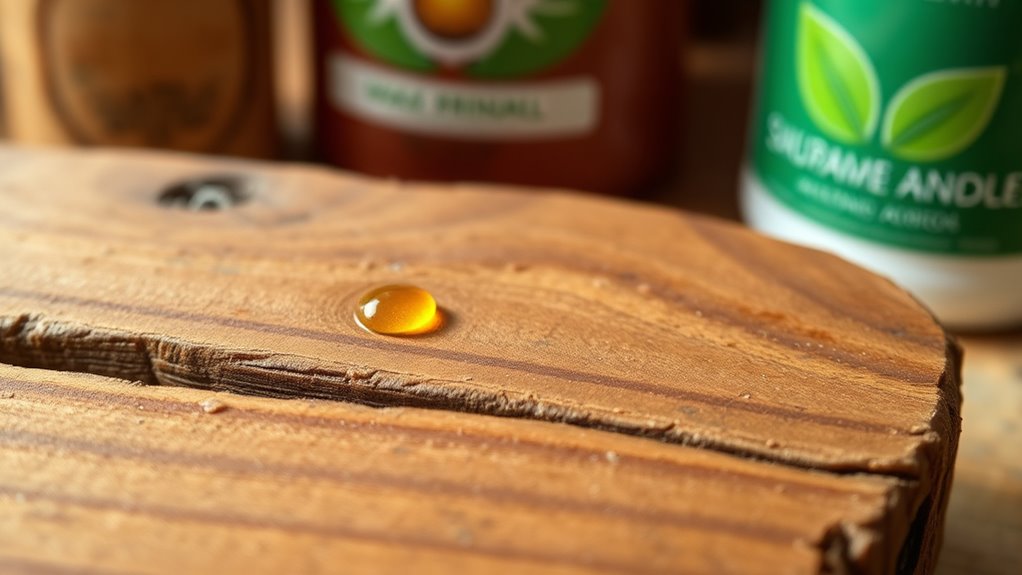
Eco-friendly wax finishes and sealants are crafted from plant-based waxes and natural oils, offering a sustainable alternative to traditional chemical-based products. You’ll find ingredients like carnauba, rice bran, and beeswax, combined with oils such as walnut and coconut oil, to penetrate deeply and protect wood. These products are free from VOCs, petrochemicals, sulfates, parabens, and synthetic fragrances, ensuring safer indoor air quality. They’re often vegan, GMO-free, gluten-free, and cruelty-free, aligning with eco-conscious standards. When applied, they create a durable, water-resistant finish that enhances the wood’s natural grain, warmth, and color. They produce a matte to satin look, maintaining the wood’s breathability. Their low odor makes them ideal for indoor spaces, furniture, and food-contact surfaces like cutting boards, supporting sustainable material use. Incorporating these finishes supports environmental sustainability, reducing reliance on harmful chemicals and contributing to healthier indoor environments. They also utilize HEPA filtration principles in their manufacturing processes to minimize airborne emissions of pollutants. Additionally, these finishes benefit from risk management principles by providing protective coatings that extend the lifespan of wood items. Cultural references to natural materials in literature highlight their timeless appeal and connection to sustainability.
Water-Based and Bio-Polyurethane Coatings
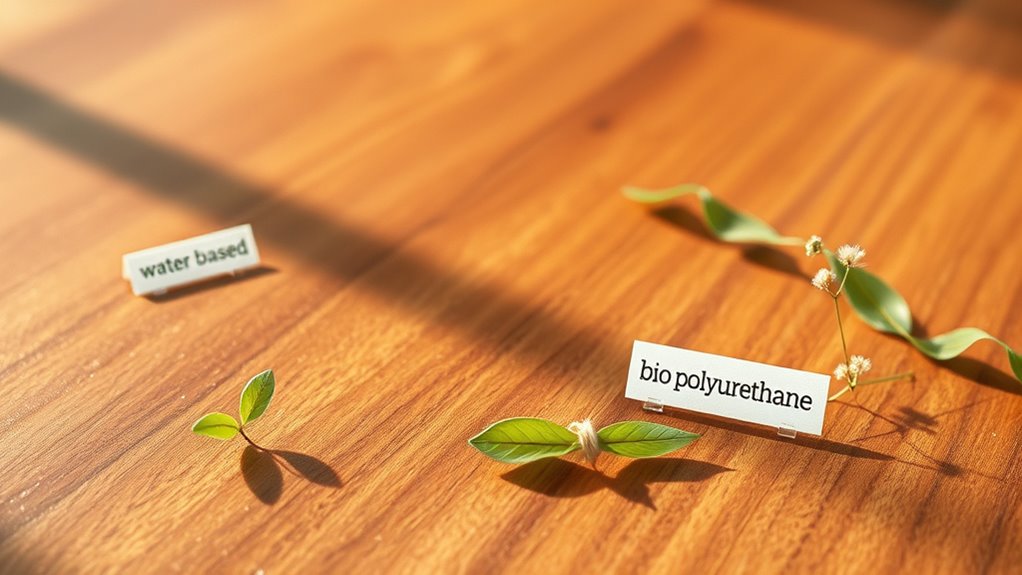
Water-based and bio-polyurethane coatings offer sustainable, durable options for finishing wood surfaces. Water-based coatings have lower VOC levels, making them more eco-friendly and safer to use indoors. They’re easy to apply with brushes, rollers, or sprayers and clean up with water, saving you time and effort. Additionally, choosing sound design techniques can help you create more engaging and immersive projects. Moreover, selecting environmentally friendly products supports broader sustainability goals. While they might need more coats and longer drying times, they provide a reliable, protective finish suitable for various interior projects. The use of eco-friendly materials further enhances their appeal by reducing environmental impact. Bio-polyurethane coatings go further by incorporating renewable ingredients like bio-solvents and resins, reducing reliance on fossil fuels. They resist UV rays, liquids, and metal marks, ensuring your wood stays beautiful longer. Plus, their non-toxic, low-emission properties make them a healthier choice for indoor environments, aligning with eco-conscious priorities. Choosing environmentally friendly products can significantly contribute to reducing your environmental footprint by minimizing harmful emissions and waste.
Benefits of Using Sustainable Wood Finishes
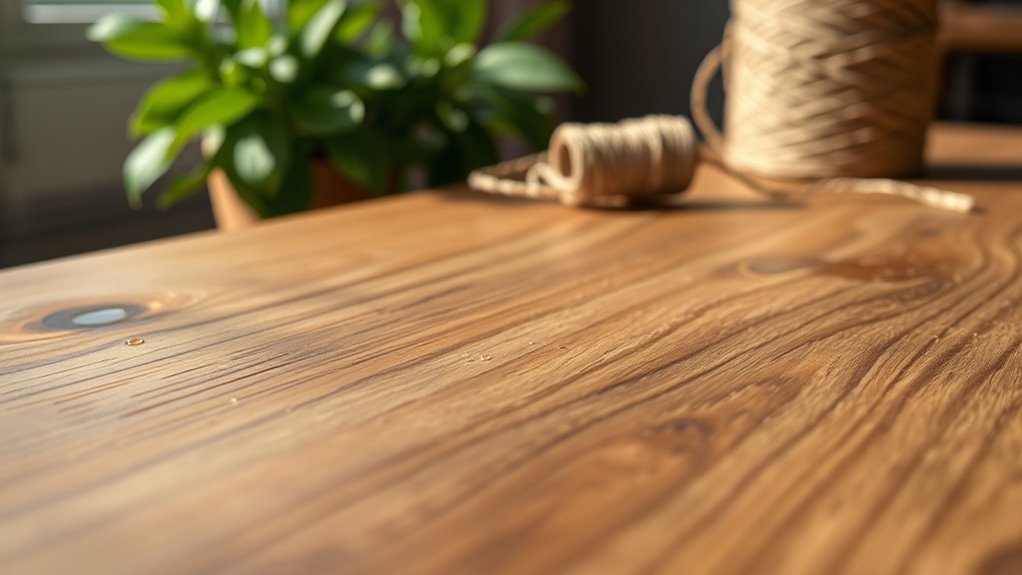
Using sustainable wood finishes offers significant health advantages by minimizing exposure to harmful fumes and toxic chemicals. These eco-friendly options emit minimal VOCs, drastically reducing irritating fumes that can harm your respiratory health. They also avoid harsh solvents and synthetic chemicals, making application safer and less irritating to your eyes and skin. Incorporating eco-friendly materials into your finishing process can further enhance the sustainability of your projects. Additionally, choosing products with third-party certifications ensures that the finishes meet strict environmental and safety standards.
Reduced VOC emissions mean fewer long-term health risks like headaches, dizziness, and chronic respiratory issues, especially for sensitive individuals such as children and the elderly. Furthermore, using low-VOC finishes can contribute to better indoor air quality, benefitting everyone in your home or workspace. Choosing sustainable finishes not only protects your health but also minimizes environmental impact. With safer waste disposal and reduced chemical runoff, you help preserve ecosystems while enjoying durable, natural-looking finishes that enhance your wood projects. Incorporating community support features from eco-friendly products can further motivate and sustain your environmentally conscious choices.
Implementing energy-efficient practices in your finishing process can also contribute to reducing overall environmental impact.
Choosing Certified and Safe Finishing Products
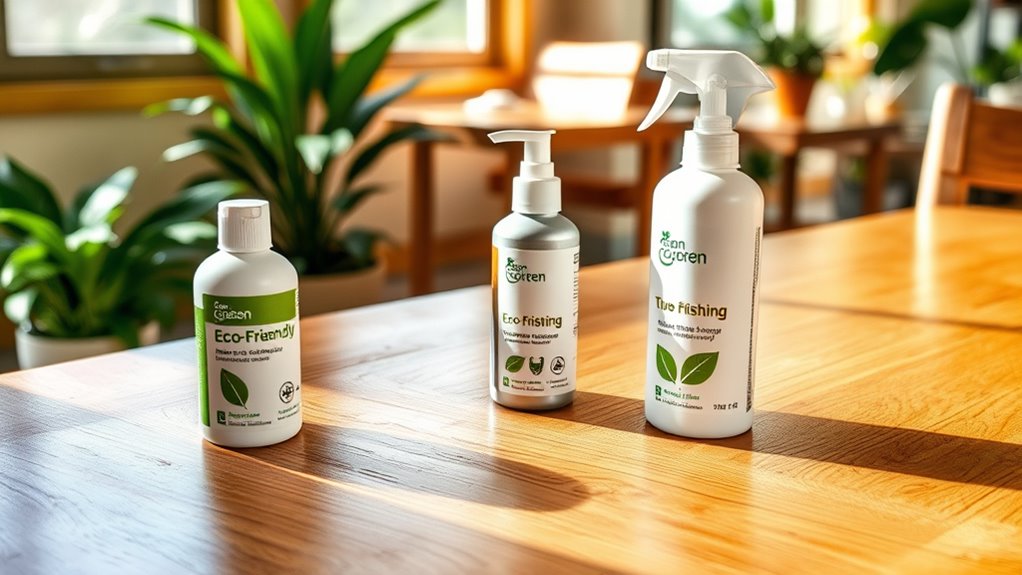
Choosing certified and safe finishing products is essential to guarantee your wood projects meet environmental and health standards. Look for certifications like GreenGuard, Green Seal, LEED, and Green Globes to ensure the products adhere to strict eco-friendly criteria. Certified finishes usually have low or no VOCs, reducing harmful emissions during and after application. Some also meet WELL Building Standard and ILBC certification, promoting healthier indoor air quality. Check detailed specification data to verify performance and safety. Selecting these products supports sustainable building practices while delivering high-quality finishes. Additionally, choosing products with eco-friendly formulations can further diminish environmental impact and improve overall safety. Focus on non-toxic formulations free from harmful chemicals, and prefer plant-based bio-polyurethanes and water-based options for easier cleanup and reduced environmental impact.
Frequently Asked Questions
How Long Do Eco-Friendly Wood Finishes Typically Last?
You might wonder how long your eco-friendly wood finish lasts. Typically, oil-based eco-friendly stains give you 5 to 8 years of protection, especially on vertical surfaces.
Waterborne finishes last around 3 to 7 years, while natural oils and waxes need reapplication every 1 to 3 years.
Some non-toxic treatments can even last a lifetime, but overall, your finish’s durability depends on application, exposure, and maintenance.
Are Natural Oil Finishes Suitable for Outdoor Furniture?
You might think outdoor furniture is like a delicate flower, but natural oil finishes are like a protective shield. They penetrate deep into the wood, guarding against moisture, UV rays, and mold.
While they require regular reapplication, they offer a natural, eco-friendly way to preserve your furniture’s beauty and durability.
Just remember, they need more frequent upkeep than synthetic options, especially in harsh weather.
Can Eco-Friendly Finishes Be Used Over Painted Surfaces?
You can definitely use eco-friendly finishes over painted surfaces, but first, make sure the paint is compatible. Proper surface preparation is key—you should clean and sand the area to ensure good adhesion.
Keep in mind that some eco-friendly finishes might need special primers or multiple coats for durability. With the right prep work and product choice, you’ll achieve a beautiful, long-lasting finish that’s also environmentally friendly.
What Is the Average Curing Time for Natural Oil Finishes?
The average curing time for natural oil finishes typically ranges from 15 to 30 days to reach full durability.
You’ll notice surface drying within 8 to 24 hours, but complete curing takes longer, depending on factors like oil type, application thickness, and environmental conditions.
To guarantee proper curing, apply thin coats, wipe off excess, and maintain stable temperature and humidity.
Avoid heavy use until the finish fully cures for ideal results.
Do Eco-Friendly Finishes Require Special Maintenance or Reapplication?
You might wonder if eco-friendly finishes need special maintenance or reapplication. They typically do, often requiring more frequent touch-ups than synthetic options to keep them protected and looking good.
Regular cleaning, light sanding, and spot repairs with natural oils or waxes make maintenance easier.
Oil-based finishes penetrate deeply for longer-lasting protection, while waxes or shellacs need more frequent reapplications.
Conclusion
By choosing eco-friendly wood finishes, you not only protect your projects but also honor the Earth’s delicate balance, much like the ancient craftspeople who valued harmony with nature. Embrace sustainable options, and you’ll craft with purpose and integrity—leaving a legacy as enduring as the timeless wisdom of those who came before. Let your choice reflect a commitment to beauty and responsibility, ensuring your creations resonate with both elegance and conscience.
